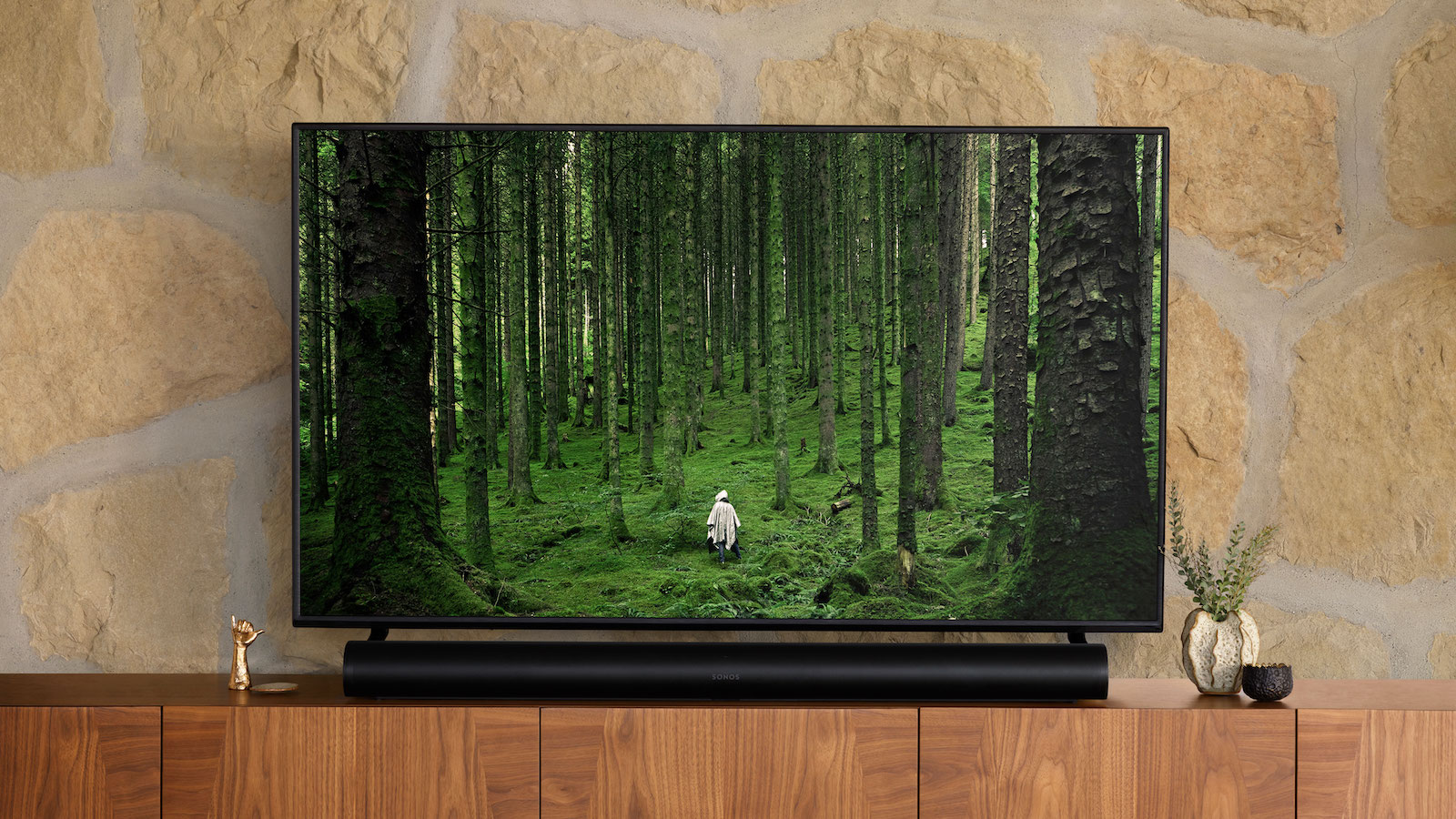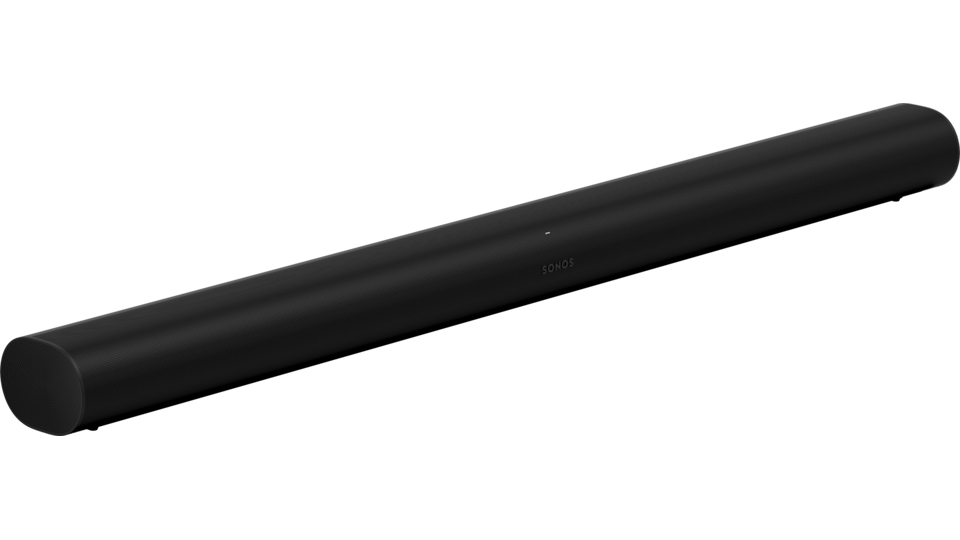This Sky, Samsung TV and Sonos soundbar system makes for heavenly home cinema
Bask in AV reverie with this thrilling TV and soundbar combination

The size of the average television screen has increased almost exponentially over the past couple of decades, to the point where it’s almost pointless for many people even to consider a projector for their home cinema thrills, given the average size of most living rooms.
The sound produced by these big-screen sets, however, is still playing catch-up – although it is improving generation by generation. The ideal set-up for a premium audio-visual system is still undoubtedly an AV amplifier and surround speaker set-up. But for many people a soundbar seems like the best way to go to boost their set’s iffy sonics; for reasons of cost and space, certainly, but also because, in the past few years, they have also got really rather good.
For this ‘simple’ solution, then, we’ve plumped for Samsung’s top-of-the range 4K QLED TV and married it with the Sonos' Dolby Atmos soundbar, with the best TV service in the UK thrown in for binge-watching good measure.
The system
Television: Samsung QE65Q95T (£1989)
Source: Sky Q (£various)
Soundbar: Sonos Arc (£799)
Total: £2788 (+ Sky Q subscription)
As a source, there’s really not much out there to beat Sky’s hugely impressive Sky Q service – although, inevitably, you’ll have to pay a substantial sum each month for those delights.
So let’s start with that Samsung QE65Q95T – not least as it's the part of this system enjoying the biggest discount over its original RRP. Down from £2999 to £1989, this is a 4K QLED model with a direct, full-array backlight. There’s a new version of the Quantum Processor 4K, which brings new features over last year’s models, such as Ultimate Precision Processing, designed to reduce banding in lower-resolution content, and upgrades to existing features such as Texture Creation (for increased perceived detail) and Active Tone Mapping (for highlights that better combine punch and authenticity).
Get the What Hi-Fi? Newsletter
The latest hi-fi, home cinema and tech news, reviews, buying advice and deals, direct to your inbox.

The brightest parts of the Q95T’s picture are noticeably less bright than those of last year’s Q90R, presumably because the comparatively low number of dimming zones means it has to be more cautious in terms of contrast, but there’s still plenty of punch, particularly with Local Dimming set to High.
There’s also a degree of authenticity and naturalism to the picture that the Q95T’s predecessors lacked. It’s in the colours, which have a rare depth and richness to them; the edges, which are somehow sharp and smooth at the same time and subsequently create a picture that’s fantastically solid without appearing forced; and the detail, which is clear and textured but never exaggerated.
Black levels are excellent, too: almost as deep as those you’d get from an OLED and with more than enough detail to dig up textures and reflections in gloom scenes.
There’s no hint of blooming, leakage or any other inconsistencies to the backlight, either. No element of the picture is distracting at all, leaving you free to be engrossed in what you’re watching.

Serious gamers will also be delighted to read that Samsung’s 2020 TVs have even less input lag than their predecessors. We’re not sure they needed to be any quicker than before, but the 10ms figure will at least see Q95T owners win that particular round of TV-spec Top Trumps. There are a number of game specific picture features to experiment with, too, although we largely prefer those left turned off.
This set is an improvement on last year’s Q90R in practically every way. It doesn’t go as bright in real terms, and HDR images sizzle a little less as a result, but its performance is richer, more solid and more natural. It’s also a significant step forward in terms of motion and sound. And, crucially, these improvements come at a lower price.
Samsung’s 4K TVs continue to lack official HDMI 2.1 certification, but the company says that the only part of the HDMI 2.1 specification that is missing is support for 8K, which rather makes sense for a 4K TV.
While the TV’s sound via its eight drivers has improved – a sign at least of the continuing improvement in flat-panel sonics – there is still no question that investment in a good soundbar will reap huge sonic rewards. After all, when you’ve bought a top-of-the-range television, it would be a shame not to enjoy superb sound to go with your pristine picture.

And that, of course, is where the Sonos Arc comes in. A 2020 Award winner, it's the company’s first foray into Dolby Atmos surround sound – and a successful one at that.
The Arc's Dolby Atmos soundfield is generated by 11 Class D digital amplifiers that power 11 custom drivers, each used to bounce sound off your walls and ceiling to create a 3D audio effect. The soundfield can be tailored to your room using Sonos' Trueplay technology, too. The result is one of the most convincing Atmos presentations of any soundbar we’ve heard.
Play the bombing run scene from Unbroken and we’re immediately transported to within the fuselage of the B-24 Liberator. Our listening room is filled with wind noise and the whirr of the plane’s engines, and the incidental creaks and rattles are placed in specific spots, including right in the top corners of the wall we’re sitting against. The Arc is dynamically deft too – both with smaller and large-scale shifts – and it’s this combination of qualities that makes the performance so evocative.
While you can add a Sonos Sub to the Arc, we don't think there's any need. There are vast quantities of deep, weighty and tuneful bass from the bar, and the lower frequencies never overwhelm and even at its loudest and deepest. The Arc really is a stunning performer.
Note that, at 114cm, it is a bit wider than a typical modern 49in TV and proportionally best partnered with at least a 55in model – it should fit very nicely in front of the Samsung we have here. Both the soundbar and TV support eARC HDMI and so can pass Dolby Atmos signals seamlessly between them.
The benefit of a decent soundbar is only too clear with the Sonos Arc. Not only is the crisp, dynamic audio significantly beyond what you’ll get from your flat panel, this device is sonically superior to all of its similarly priced rivals. Of course, those looking to use their bar to stream music – either on its own or as part of a wider home Sonos set-up – are well catered for, with the Sonos S2 platform a gateway to all the music service apps you'd expect.
Sky Q, our chosen source here of course, has an increasing number of Atmos titles in its catalogue, as do streaming services such as Netflix, Disney+ and Apple TV+ – so now's a great time time to delve into Dolby Atmos. And, currently, there's no better way to do that under a grand than with the Arc. (Got a bigger budget? The thrice-the-price Sennheiser Ambeo is your bar.)

We haven’t left too much space for our source – it is, after all, such a well known service that there’s not too much to add.
Sky Q was the biggest overhaul Sky had given to its package since it introduced Sky+, aiming to do for television what Sonos did to music – and make it truly multi-room. It’s not a cheap service, inevitably, but if you want a service that pretty much has it all, from 4K, Dolby Digital and Dolby Atmos, to multi-room and a huge back catalogue of films, box-sets and programming, Sky Q is it.
And now that it has finally added HDR content to its service, it’s as complete a package as you can get.
Sky Q feels utterly contemporary, combining almost every way of watching TV and allowing you to access them all over your home (and, to an extent, outside). This is as good as TV gets – if you can bear the not inconsiderable cost. So it’s a no-brainer, really, for this brilliant home cinema package.
MORE:
Best soundbars 2020: the best TV speakers you can buy
Best TV 2020: budget to premium 4K Ultra HD TVs

Jonathan Evans is the editor of What Hi-Fi? magazine, and has been with the title for 18 years or so. He has been a journalist for more than three decades now, working on a variety of technology and motoring titles, including Stuff, Autocar and Jaguar. With his background in sub-editing and magazine production, he likes nothing more than a discussion on the finer points of grammar. And golf.
